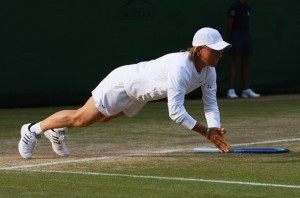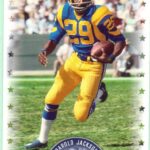Queens of the Court: Martina Navratilova, Lifting The Game To New Heights

Martina Navratilova dominated women's tennis for more than a decade.
Her achievements on the tennis court are almost without parallel.
Her energy in supporting the rights of others has been a constant.
Her passion for the sport that she says “gave her a soul” is unquestioned.
Yet it is one particular interview, following one particularly unlikely event in this tennis icon’s life, that throws as much light on her character as any of those achievements.
Martina Navratilova was a surprise participant, and a surprisingly popular finalist, in the 2008 television show “I’m a Celebrity…Get Me Out Of Here.” And in an interview for the U.K.’s revered Times newspaper, she admitted it was simply the challenge that made her sign up.
“I want challenges, whether cerebral or physical…If you never push yourself, you won’t know what your point of failure is. People always said I was so competitive. Not with other people, with myself.”
This gets to the heart of what made Navratilova one of the most successful women ever to pick up a tennis racket: the need to prove to both herself and the world what was possible.
However, there is a second quote that gets to the heart of what makes her such an enduring, respected, and important woman beyond the tennis court.
“If I feel strongly, I say it. I know I can do more good by being vocal than by staying quiet. I’d have a whole lot more money if I lied, but I wouldn’t have enjoyed spending it.”
This is the story of a courageous, feisty, and generous woman who also happened to challenge political repression and personal prejudice on her way to becoming one of the world’s greatest living athletes.
“You can’t live in the past.”
Navratilova was born in October 1956, in Prague, Czechoslovakia, but her ski-instructor father and her mother divorced when she was still very young.
Tennis ran in her family. Her grandmother had been an international player and, when her mother remarried in 1962, her stepfather became her coach.
By the age of eight, Navratilova reached the semifinals of her first tournament, and her talent began to attract the attention of the Czech authorities.
In 1972, age 15, Navratilova won the Czech national tennis championships. The next year, she reached the quarterfinals of the French Open and the third round of Wimbledon.
She also met, and was beaten for the first time by, the woman who would forever become associated with her career, Chris Evert.

Navratilova and Chris Evert first met on the court in 1975. Evert and the other players on tour became Navratilova's surrogate family following her defection.
But it was 1975 that became one of those watershed moments for Navratilova.
It was the year when she turned professional.
It was the year she became runner-up in two Grand Slam singles tournaments (to Evonne Goolagong in Australia and to Evert in the French).
And it was the year when her background collided with her future.
“Just go out there and do what you have to do.”
In 1968, the Soviet army had invaded Czechoslovakia and forcibly imposed an orthodox communist regime on a country that was attempting to move towards more liberal politics.
In the years that followed, Navratilova frequently came into conflict with the new regime, offending the authorities by publicly expressing opinions that conflicted with the official line. Her movements were shadowed by Czech security, and she had become used to having most of her winnings commandeered by the regime.
She was warned that further “offenses” would lead to her being denied the exit visas she needed in order to travel outside Czechoslovakia.
In that watershed summer of 1975, the visa she needed to take part in the U.S. Open was indeed refused, and it was only the interception of her countryman, the former French Open champion Jan Kodes, that changed the decision.
So she took the decision to defect. After losing to Evert in the semifinals, the 18-year-old Navratilova went to the offices of the Immigration and Naturalization Service in New York City and completed the paperwork on the spot.
Within a month, she had her green card, and she went on to gain full American citizenship in 1981.
But her decision cut her off from her family. They could not leave Czechoslovakia to visit her, and she would be arrested if she returned to her homeland.
Navratilova did not see her family for four years, and was suddenly cut adrift in a foreign country with no home and few friends. Once more, it is Evert’s name that appears in the Navratilova story, since it was Evert, with the rest of the American squad, who became the defector’s surrogate family.
But Navratilova found life hard, gained weight, lost matches, hit bottom. It would be almost three years before she and her tennis gained the confidence to win her first singles Slam title: at Wimbledon in 1978.
“Wimbledon is like a drug. Once you win it for the first time you feel you’ve just got to do it again and again and again.”
Navratilova had never even seen a grass court until a week before her first appearance in London in 1973.
Watching Wimbledon on television as a child, she imagined the grass would be a couple of inches long, like a football pitch.
When she touched the court at Queens Club, where she was practicing before Wimbledon, she could not believe how short and tightly-woven it was.
She was immediately hooked and immediately at home.
By that tumultuous year in 1975, she had reached the quarterfinals of what was to become her signature tournament.
The following year she made the semis.

Navratilova claimed the first of her record nine Wimbledon titles in 1978 with a three set victory over Evert.
After another quarterfinal exit in 1977, Navratilova won for the first time. It was the start of a record-breaking 13-year period during which she won nine singles titles, she reached the finals of three more, and made at least the semis in every year up to 1994 (barring a quarterfinal exit in 1991).
Her victories included five over Evert and one each over Andrea Jaeger, Hana Mandlikova, Steffi Graf, and Zina Garrison.
Although Graf stopped Navratilova going on to seven consecutive Wimbledon singles titles, she did not stop Navratilova both reaching and winning, in straight sets, her ninth consecutive final in 1990, at the age of 33.
Such success at such an age illustrates what distinguished Navratilova from almost every other woman in tennis at that time. It also shines a light on the influence she has had on both the male and female players who have followed.
She set herself higher benchmarks by “getting off my butt and…really starting training.” Like Andy Roddick and Lleyton Hewitt have done over the last year, she attacked her own fitness levels and retooled her skills.
She constantly evolved elements of her game such as her big, sliced, left-handed serve, her net-rushing and volley put-aways, and her tactical research.
She claims that this willingness to change enabled her to win her ninth Wimbledon title. “Billie Jean [King] helped me with my last Wimbledon singles title by changing my footwork—talk about teaching old dogs new tricks!”
A message for all times.
“All eras have their great players, but Martina straddled many eras as the greatest.” (Billie Jean King)
For some, such an assertion from King would suffice. But at some point in the story of a great tennis player, a few statistics must underpin a reputation. This is the point in Navratilova’s story.
Wimbledon, of course, shone like the North Star in Navratilova’s heavens: 12 singles finals, a record nine singles titles, and 20 Wimbledon titles in all: equaling King’s own record.
Navratilova, though, was the dominant force across the whole of women’s tennis throughout the 1980s. Indeed, she was also a major figure in the late ’70s (four Slam singles finals, two of them wins) and the early ’90s (three Slam singles finals, one of them the title).
In the Australian Open, for example, she entered the singles 10 times in a 14-year period, and never failed to reach the quarters, reached the finals six times, and won it three times.
In the U.S. Open, she entered the tournament in 21 successive years, reached the semifinals in 12 of them, the final in eight, and won the title four times.
Even at Roland Garros, the most difficult surface for her aggressive, forward-moving game, she entered 10 times between 1973 and 1987, reached the quarters in nine of them, the finals five times, and won twice.
In all, she won 18 Slam singles titles, 31 women’s doubles titles (an all-time record), and 10 mixed doubles titles.
In the year-end championships between 1975 and 1992, she won eight times and was runner-up six times. In the doubles, she won all 11 finals between 1980 and 1991.
She holds the Open era record for most singles titles (167) and doubles titles (177), and has the longest winning streak of 74 consecutive matches.
And the killer blow: from 1982 to 1984, Navratilova lost only six singles matches.
The statistics are extraordinary. But to give some perspective to the time span of her career, here’s a look at a few of the partners in her Grand Slam doubles victories.
Three of her earliest women’s titles were with King, and her last runner-up place was with Svetlana Kuznetsova.
She won her first mixed Slam back in 1974 with Ivan Molina, paired up with Paul McNamee and Peter Fleming in the ’80s, won two titles with Leander Paes, and reached her last Slam final, in 2006, with Bob Bryan.
There’s one more illuminating angle to consider in Navratilova’s record-setting.
She competed between the mid-’70s and the mid-’80s against one of the most successful women of the Open era, Chris Evert.
She then faced, from the mid-’80s until her retirement, one of the most successful women of all time, Steffi Graf.

Navratilova's career transcended generations. In 1991 she lost the U.S. Open final to Monica Seles.
Giving almost 14 years to the young Graf—whose athleticism owed a great deal to the older woman’s example—Navratilova won half their 18 matches and five of their nine Slam singles matches. In their last Slam meeting (the semifinals of the 1991 U.S. Open) the 34-year-old won 7–6, 6–7, 6–4.
Navratilova truly did stand astride the decades like a colossus.
“She helped me play longer and, most of all, she helped me play better.”
It’s a common theme in Navratilova’s life: the constant acknowledgment of the contribution from others to her own success.
She references King in almost every interview she gives.
She talks of the part played by Nancy Lieberman and Renee Richards in achieving her extraordinary fitness.
She credits her coach and step-father for the help and support they gave in her early life. And she credits—in the above quote—the champion who helped to define her career: Chris Evert.
This most enduring of all rivalries lasted 16 years. They met on 80 occasions, 60 of them in finals. Between 1975 and 1986, one or other of the them finished the season as No. 1.
Though Evert is the elder by fewer than two years, she began her Slam-winning ways at 19, while Navratilova was slower out of the blocks, winning just two Slams by the age of 25.
They had become friends before they became such great rivals, and joined forces to win the French Open doubles in that watershed year of 1975. They repeated their success at Wimbledon the next year.
As the rivalry grew, so did the distance between them, as both realised it was difficult to combine such a close friendship with the need to dominate the other. Their split was encouraged by Lieberman, who believed it was necessary to dislike an opponent to totally dominate them.
Evert led their early head-to-head 20-5. So Navratilova improved her athleticism to levels never before seen in the women’s game, and developed new strategies to take time away from the punishing base-line game at which Evert excelled.
By the end of their rivalry, the head-to-head had shifted in favor of Navratilova 43-37. They ended their careers with 18 Slam singles titles apiece.
What made their matches even more compelling was the contrasting styles and personalities they brought to the court.
Evert was adored as the all-American, feminine, prettily-modest girl-next-door, while Navratilova had a muscular, athletic, challenging demeanor. She was “out” as a lesbian—still not a universally popular admission at the time. She was also uncompromising in her focus and fiery in her desire to win.
So while Navratilova garnered the fans’ respect, it was invariably Evert who was their favorite.
What was, and remains, clear is that Navratilova always garnered popularity from her fellow players. Just as she has been quick to extend credit to others, they in turn have been enthusiastic supporters of her.
Evert and Navratilova quickly put their rivalries behind them and became firm friends once more. King has always been a friend and admirer. The same is true of long-term, record-equaling doubles partner, Pam Shriver.

Navratilova took conditioning to a new level on the women's tour.
Leander Paes’s first act after winning the French Open doubles this year was to leap into the crowd to embrace his former Slam partner: “Watching Martina play inspired me as a kid growing up in India…Thank you Martina for being my vehicle to greatness.”
Lisa Raymond, who partnered Navratilova during 2003, found her inspiring: “I think she made me a better player, a better team mate.”
Bob Bryan was wowed by her serve, her brain-power and her reflexes, and more than a little flattered to be invited, by text, to play with her.
Little wonder, perhaps, that she showed just a hint of sarcasm in talking about the I.T.F.’s decision this year to give her its highest accolade, the Philippe Chatrier Award. They had awarded the same distinction to Evert 12 years before.
Navratilova’s comment? “They waited a while!”
“Labels are for filing. Labels are for clothing. Labels are not for people.”
Navratilova retired in 1995 with one of the greatest records in tennis to her name. But her high-energy approach to life continued apace. “Taking life easy” is simply not in her DNA.
She gained her pilot’s license (and she’s afraid of heights), learned to dive (because she’s afraid of drowning), wrote a couple of mystery novels, and took up photography and painting.
She was president of the W.T.A. players’ association for many years during the ’80s and ’90s.
She has always dedicated her time and energy to political and social causes. Her work in support of equality for gay and lesbian rights is well known, but she is also a vociferous campaigner for animal welfare and for environmental causes.
In short, she lives by her own beliefs: “Don’t get limited by people who say ‘No, you can’t do that because you’re too old or because you’re heavy or you’re not an athlete.’ Whatever your limitations might be, don’t let them define you. I didn’t let them define me.”
As a result, when she decided in 2000, aged 43, that she wasn’t ready to turn her back on tennis, it was an easy decision to commit to a limited schedule again. She had stayed supremely fit, and wanted to join the new young players, not the “senior tour.”
She won a dozen women’s doubles titles, including the mixed titles in two Slams, with a half-a-dozen different partners.
She played in her first Olympics.
She stretched her Fed Cup record to 40-0 before a final loss in 2004 marred her perfect sheet.
What she also won was the enthusiastic support of crowds wherever she played, and that clearly meant a lot: “What I’m getting from the crowd I never got in my life…I didn’t expect that.”
“I hope, when I stop, people will think that somehow I mattered.”
When she did finally hang up her racket, it was done in style, after one final Grand Slam victory, at what she regarded as her home tournament in Flushing Meadows, with American partner Bob Bryan. She turned 50 a month later.
Now she is still relishing a whole new set of challenges.
There are the personal challenges, from “I’m A Celebrity…” to auditioning for the London production of Chicago.
There’s the ongoing need to challenge prejudice, from campaigning for gay rights, to writing books for the over-50s on physical and mental health, to public speaking about aspiring to new goals.
Then there’s tennis: she’s been forthright in her condemnation of high-volume grunting on court, and is keen for today’s women to take a leaf out of the men’s game and mix up their play.
For Navratilova, it’s always been about pushing herself beyond her comfort zone, refusing to be limited or defined by her career, her age or her sexuality.
This therefore continues to be the story of a courageous, feisty, and generous woman who happens to be one of the world’s greatest living athletes. Watching footage of Navratilova in full flow, rushing the net even on clay, picking off every shade of volley to perfection, is still one of tennis’s joys.
It seems appropriate, therefore, to give the closing words to one of her oldest friends. King said of Navratilova in 2006, “She’s the greatest singles, doubles and mixed doubles player who’s ever lived.”
I, for one, have no intention of arguing.
A short appreciation of Navratilova, with a three-minute video of her first Wimbledon singles win in 1978 against Christ Evert, can be seen on the Wimbledon website .
Read other articles in this series about great women players and their contribution to tennis:













